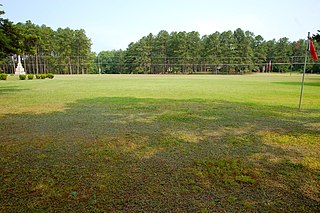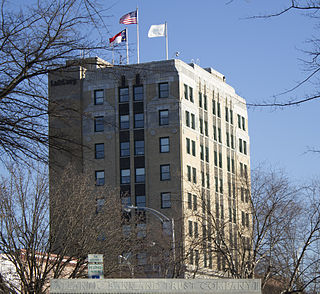
Burlington is a city in Alamance and Guilford counties in the U.S. state of North Carolina. It is the principal city of the Burlington, North Carolina Metropolitan Statistical Area, which encompasses all of Alamance County, in which most of the city is located, and is a part of the Greensboro-Winston-Salem-High Point CSA. The population was 50,042 at the 2010 census, which makes Burlington the 17th largest city in North Carolina. The Metropolitan Statistical Area population was over 150,000 in 2010.

Mebane is a city located mostly in Alamance County, North Carolina, United States, and partly in Orange County, North Carolina. The town was named for Alexander Mebane, an American Revolutionary War general and member of the U.S. Congress. It was incorporated as "Mebanesville" in 1882, and in 1883 the name was changed to "Mebane". It was incorporated as a city in 1987. The population as of the 2010 census was 11,393. Mebane is one of the fastest growing municipalities in North Carolina. Mebane straddles the Research Triangle and Piedmont Triad Regions of North Carolina. The Alamance County portion is part of the Burlington Metropolitan Statistical Area, which is a component of the Greensboro-Winston-Salem-High Point Combined Statistical Area. The Orange County portion is part of the Durham-Chapel Hill Metropolitan Statistical Area, which is a component of the Raleigh-Durham-Chapel Hill Combined Statistical Area.

Alamance Battleground is a North Carolina State Historic Site commemorating the Battle of Alamance. The historic site is located south of Burlington, Alamance County, North Carolina in the United States.

Glencoe is an unincorporated community in Alamance County, North Carolina on North Carolina Highway 62, north-northeast of downtown Burlington.

Bellemont is an unincorporated community in Alamance County, North Carolina, United States.
Burlington Historic District may refer to:

The former US Post Office, also known as the US Post Office/Federal Building, is an historic red brick post office building located at 430 South Spring Street in downtown Burlington, North Carolina. Built in 1936, it was designed in a mixture of the Classical Revival and Moderne or Art Deco styles by architect R. Stanley Brown who worked under Louis A. Simon, head of the Office of the Supervising Architect.

Charles C. Hartmann (1889–1977) was an American architect.

Alamance Hotel is a historic hotel located at Burlington, Alamance County, North Carolina. It was designed by architect Charles C. Hartmann and built in 1924. It is a seven-story, brick sheathed building in the Classical Revival style. It features terra cotta ornamentation, a brick parapet, and stuccoed panels at the uppermost floor.

Atlantic Bank and Trust Company Building, also known as the North Carolina National Bank Building, is a historic bank building located at Burlington, Alamance County, North Carolina. It was designed by architect Charles C. Hartmann and built in 1928-1929. It is a nine-story, steel-framed midrise in the Art Deco style. It features rich granite ornamentation at the bottom and top pairs of stories.

Efird Building is a historic commercial building located at Burlington, Alamance County, North Carolina. It was built in 1919, and is a three-story, Gothic Revival style building. The front facade is sheathed in white enamelled terra cotta tile. It housed a branch of Efird's Department Store based in Albemarle, North Carolina.

Southern Railway Passenger Station is a historic train station located at Burlington, Alamance County, North Carolina. It was built in 1892 by the North Carolina Railroad, and is a rectangular, one story red brick and wood building in a Victorian Tudor style. It features a hipped roof with flared eaves, decorative brackets, and an octagonal tower and two triangular dormers.

Lakeside Mills Historic District is a national historic district located at Burlington, Alamance County, North Carolina. It encompasses 20 contributing buildings built in the 1890s. The district includes a one-story brick mill and ancillary buildings, 16 one-, 1 1/2- and two-story frame houses, and a store building.

West Davis Street–Fountain Place Historic District is a national historic district located at Burlington, Alamance County, North Carolina. It encompasses 138 contributing buildings in a primarily middle-class residential section of Burlington. Most of the dwellings date to the late-19th and early-20th century and include representative examples of Queen Anne and Colonial Revival style architecture.

East Davis Street Historic District is a national historic district located at Burlington, Alamance County, North Carolina. It encompasses 43 contributing buildings in a primarily residential section of Burlington. It includes single and multi-family dwellings, one commercial building and one church that were predominantly constructed from the 1880s to 1950. The buildings include representative examples of Queen Anne and Classical Revival style architecture.

North Main Street Historic District is a national historic district located at Graham, Alamance County, North Carolina. It encompasses 72 contributing buildings and 1 contributing structure in the central business district of Graham. The district includes a variety of institutional, commercial, and residential buildings largely dating from the 19th century. Notable buildings include the Alamance County Courthouse, the centerpiece of the district; Graham Presbyterian Church; Harden House; Hunter House; Nicks Store; McBride Holt House ; Scott Building ; Vestal Hotel; Holt-Scott General·Store ; National Bank of Alamance ; Mont-White Theatre; and Paris Building.

Mebane Commercial Historic District is a national historic district located at Mebane, Alamance County, North Carolina. It encompasses 30 contributing buildings, and 1 contributing structure in the central business district of Mebane. The district includes one and two-part commercial blocks of one to three stories in height, executed in the Colonial Revival and Neo-Classical styles. The earliest buildings date to about 1905. Notable buildings include two former banks, the Five Star Building, Mebane Enterprise Building, and Jones Department Store Building.

Thomasville Downtown Historic District is a national historic district located at Thomasville, Davidson County, North Carolina. The district encompasses 46 contributing buildings, 1 contributing site, 2 contributing structures, and 2 contributing objects in the central business district of Thomasville. It includes commercial and governmental buildings built between 1871 and 1938. Located in the district is the separately listed Thomasville Railroad Passenger Depot. Other notable contributing resources include The Big Chair (1950), the former City Hall (1938), the former Davidson County Office Building, the former United States Post Office (1926), (former) Davidson County Office Building (1957), the Dr. Orien R. Hodgin Dental Office, the North State Telephone Warehouse, First National Bank of Thomasville (1922), C. R. Thomas Block, and the Lambeth Furniture Company/Thomasville Chair Company.

Downtown Mocksville Historic District is a national historic district located at Mocksville, Davie County, North Carolina. The district encompasses 21 contributing buildings and 1 contributing object in the central business district of Mocksville. It primarily includes residential and commercial buildings with notable examples of Classical Revival and Beaux-Arts style architecture. The district includes the previously listed Davie County Courthouse. Other notable buildings include the Davie County Jail (1916), (former) C. C. Sanford Sons Store (1937), (former) J. T. Baity/Anderson Store, (former) Meroney Hardware Company Building (1922-1924), Sanford Brothers Building (1927), (former) Southern Bank &. Trust Company Building (1923), (former) Princess Theatre, J. T. Angell Building (1910), Horn Service Station, (former) Kurfees and Ward Pure Oil Station, (former) Meroney Filling Station, and Johnstone Office Building (1939).

Downtown Gastonia Historic District is a national historic district located at Gastonia, Gaston County, North Carolina. It encompasses 77 contributing buildings and 1 contributing object in the central business district of Gastonia. The commercial, civic, institutional, and multi-unit residential buildings were built between the 1890s and 1954, and include notable examples of Colonial Revival and Classical Revival architecture. Located in the district are the separately listed former Gaston County Courthouse, First National Bank Building, Third National Bank Building, and Robinson-Gardner Building. Other notable buildings include the U.S. Post Office (1935), York Medical Building (1938), Kress Department Store, Leibowitz Department Store, Ideal Moving Picture Theater, City Hall, Kirby Building (1922), First Baptist Church (1922), Gaston County War Memorial Hall (1928), and the (former) Gaston County Public Library (1930).



















